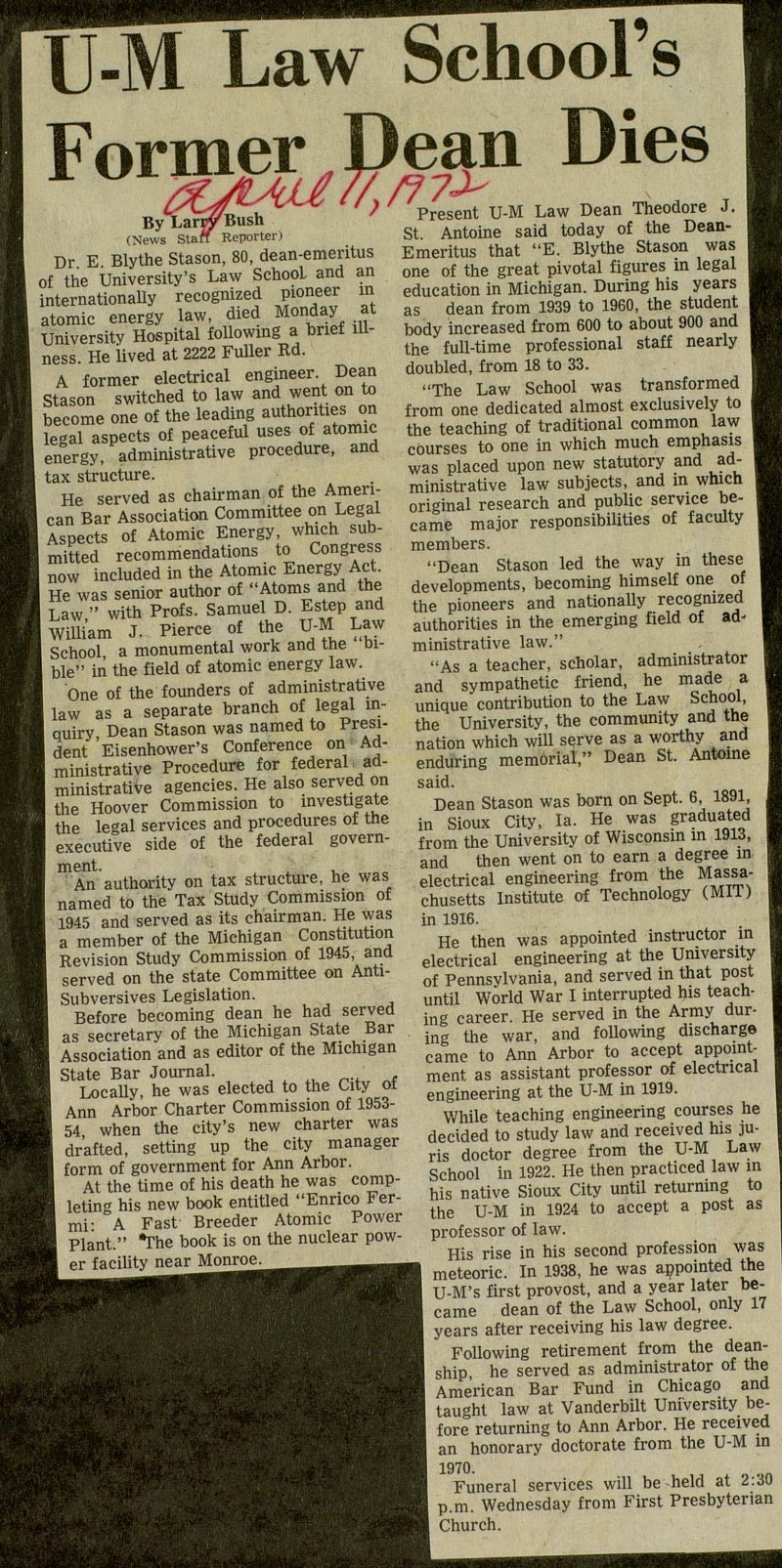U-M Law School's Former Dean Dies


Dr E Blythe Stason, 80, dean-ementus of the University's Law SchooL and an internationally recognized pioneer m atomic energy law, died Monday at University Hospital following a brief illness. He lived at 2222 Fuller Rd. A former electrical engineer Dean Stason switched to law and went on to become one of the leading authonties on legal aspects of peaceful uses of atomic energy, administrative procedure, and I tax structure. He served as chairman of the AmenI can Bar Association Committee on Legal Aspects of Atomic Energy, which submitted recommendations to Congress now included in the Atomic Energy Act. He was senior author of "Atoms and the Law " with Proís. Samuel D. E step and Wiïïiam J. Pierce of the U-M Law I School, a monumental work and the biI ble" in the field of atomic energy law. One of the founders of administrative I law as a separate branch of legal mI quiry, Dean Stason was named to PresiI dent Eisenhower's Conference on AdI ministrative Procedure for federal, adI ministrative agencies. He also served on I the Hoover Commission to investígate I the legal services and procedures of the I executive side of the federal governAn authority on tax structure, he was I named to the Tax Study Commission of 1945 and served as its chairman. He was I a member of the Michigan Constitution I Revisión Study Commission of 1945, and served on the state Committee on AntiI Subversives Legislation. Before becoming deán he had served I as secretary of the Michigan State Bar I Association and as editor of the Michigan I State Bar Journal. Locally, he was elected to the City of Ann Arbor Charter Commission of 1953I 54 when the city's new charter was I dr'afted, setting up the city manager I form of government for Ann Arbor. At the time of his death he was comp■ leting his new book entitled "Enrico Fermi- A Fast Breeder Atomic Power I Plant." The book is on the nuclear powI er facility near Monroe- 7A I Present U-M Law Dean Theodore J. I St Antoine said today of the DeanEmeritus that "E. Blythe Stason was I one of the great pivotal figures in legal I education in Michigan. During his years I as dean from 1939 to 1960, the student I body increased from 600 to about 900 and I the full-time professional staff nearly doubled, from 18 to 33. "The Law School was transformed I from one dedicated almost exclusively to I the teaching of traditional common law I cóurses to one in which much emphasis I was placed upon new statutory and ministrative law subjects, and in which I original research and public service became major responsibilities of faculty members. "Dean Stason led the way in these I, developments, becoming himself one of the pioneers and nationally recogmzed authorities in the emerging field of aöministrative law." "As a teacher, scholar, administrator and sympathetic friend, he made a unique contribution to the Law School, the University, the community and the nation which will se,rve as a worthy and enduring memorial," Dean St. Antoine said. Dean Stason was bom on Sept. 6, 1891, 1 in Sioux City, Ia. He was graduated from the University of Wisconsin in 1913, and then went on to earn a degree in electrical engineering from the Massachusetts Institute of Technology (MIT) in 1916. He then was appointed instructor in electrical engineering at the University of Pennsylvania, and served in that post until World War I interrupted his teaching career. He served in the Army during the war, and following discharge carne to Ann Arbor to accept appointment as assistant professor of electrical engineering at the U-M in 1919. While teaching engineering courses he decided to study law and received his juris doctor degree from the U-M Law School in 1922. He then practiced law in his native Sioux City until returmng to the U-M in 1924 to accept a post as professor of law. His rise in his second profession was ■ meteoric. In 1938, he was appointed the I U-M's first provost, and a year later beI carne deán of the Law School, only 17 I years after receiving his law degree. Following retirement from the deanI ship he served as administrator of the I American Bar Fund in Chicago and I taught law at Vanderbilt Umversity beI fore returning to Ann Arbor. He received I an honorary doctórate from the U-M in Funeral services will be -held at 2:30 I p.m. Wednesday from First Presbytenan I Church. ifi
Article
Subjects
Larry Bush
Obituary
Ann Arbor News
Old News
E. Blythe Stason
2222 Fuller Rd